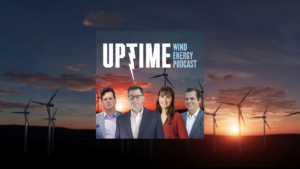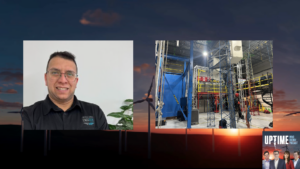Podcast: Play in new window | Download
Allen Hall and Joel Saxum interview Alex Jones, co-founder of DSPTCH, about the app’s evolution from a wind farm locator to a comprehensive operations management and IRA compliance tool for renewable energy. They discuss new features, prevailing wage and apprenticeship tracking, industry adoption, and how DSPTCH improves efficiency and safety in wind farm operations.
Visit https://dsptch.app/ or download at https://dsptch.app.link/.
Sign up now for Uptime Tech News, our weekly email update on all things wind technology. This episode is sponsored by Weather Guard Lightning Tech. Learn more about Weather Guard’s StrikeTape Wind Turbine LPS retrofit. Follow the show on Facebook, YouTube, Twitter, Linkedin and visit Weather Guard on the web. And subscribe to Rosemary Barnes’ YouTube channel here. Have a question we can answer on the show? Email us!
Pardalote Consulting – https://www.pardaloteconsulting.com
Weather Guard Lightning Tech – www.weatherguardwind.com
Intelstor – https://www.intelstor.com
Allen Hall: Welcome to the Uptime Wind Energy Podcast. I’m your host, Allen Hall, along with my co host, Joel Saxum. When we first discovered the software app DSPTCH, Joel and I used it to find wind farms but DSPTCH is so much more than a wind map today. DSPTCH is now widely used by operators for managing projects, handling forms, timesheets, apprenticeship tracking, and so much more.
Our guest is Alex Jones, co founder and president of DSPTCH. Alex, welcome to the show.
Alex Jones: Yeah, thanks for having me.
Allen Hall: So I. Went back into my DSPTCH app and got access to the online computer version of the DSPTCH app and was just astounded at all the advanced features you’ve added roughly over the last year.
I think I, I picked up the app when we were in New Orleans at ACP and. it to full fine wind farms, particularly with technicians on site that didn’t know where their own wind turbines were. So it was really helpful there, but you want to talk about some of the things you guys are doing now?
Alex Jones: Yeah, for sure.
This year at OMS, we launched a new product the safety side, we call it oversight and it really just gives asset owners and EPCs, really anyone who wants to come in Yeah. The ability to manage that site, add points put in emergency documents, emergency contacts. And we’ve really gone long on that front.
So we had one of our clients and utility partners reach out and they were making flyers for DSPTCH for fire departments, EMS, so on and so forth. And we were like, okay explain what you’re doing. And we’ve turned that into a product now, and we’ve seen a huge surge in local first responders, emergency teams getting on there’s been a few Incidents recently in the industry and then you add in tornadoes and wildfires and all these other things.
So people are looking to map. Hey, I want to know where my tornado shelters are. I want to know local emergency response teams phone numbers for emergency contacts and then even things like helicopter landing points. So we now support adding all of those things to the map and then updating any information like about the site itself, adding documents, those sorts of things.
And so we’ve really seen that take off and become a part of site orientation for a number of asset owners and so on. And it’s evolved into a pretty neat safety tool.
Joel Saxum: Yeah. I was thinking about this I’m speaking from the mind of a traveling wind turbine technician, right?
Cause this comes from my oil and gas past every site you go on every O& M building you visit. They hand you your sheet of paper. This is your ERP, your emergency response plan. This is where the, the tornado shelter is. This is where the O& M building is. Here’s the closest hospital, all these different things.
Now you have a living one that’s in your phone. Every technician has their phone on them all the time. That’s just a given, right? So then, and if there is a massive update, Oh, we’re using a different thing. Are we moved the truck? Cause we’ve seen the, Alan, you and I have seen those moving tornado shelters, right?
Basically you just pick them up on a truck and put them somewhere else. They’re crazy. But that’s a living document now, right? You’re not scrambling or you get in your truck and you’re like, Oh man, someone got bit by a snake. Who do I call? And you’re going through the ERPs or in the advisor or in, tucked away in the back of the seat or something like, Oh, what’s that phone number?
Now you know, you have it. Cause you’re on, you’re on wherever you’re at XYZ wind farm. Boom. You’re boom. There it is. That’s fantastic. So the oversight part of the product gives people the ability to claim, Hey, this is my wind farm. And then, Hey, we’re going to add all these different things in.
They can keep it private or is it all public or how does that work?
Alex Jones: Yeah. So a few different ways we have the ability. So we’re rolling out pretty soon the site checking capability. So anybody who’s physically on site, we’ll get access to a little bit extra. You can’t have company documents, company forms.
One of the things that we’re working towards is right now our form tool allows you to have a sort of a single pane of glass. So the idea is any vendor, any technician that comes to your site, you’re getting full tracking of every work order, every, QA, QC document against a turbine and all of that just being a nice standard way that you don’t have to have PDFs and CSVs and all those things flying around for every internal and external vendor.
And then to some degree, it allows a number of these companies as they move to self perform to just improve their ability to do that. They’re not locked into some tool or have their data behind a paywall. If they pick one partner or the other. And then we’ve seen a large adoption with EPCs lately, just.
They want to map lay down yards, roads before they’re there. One of those stories we had was, getting a gearbox during a cell delivered to the wrong tower. Now you’ve got, crane sitting idle, you’ve got folks sitting idle and it’s okay, I’ve got to go find a flatbed, get them to come back out here, pick it back up and move it a quarter of a mile.
And by the time you’re done with that, it’s okay, we had two days of everybody kind of twiddling their thumbs, waiting around for one thing to move. And Yeah, that’s been a nice use case. I think the safety side is really where we’ve seen the most uptick, but now with all this new build growth, it’s a frantic phone call or text message of hey, why isn’t this site in DSPTCH?
And it’s like you are, You’re literally building a lay down yard right now. I don’t know how you thought we would know that.
Joel Saxum: But if you’re killing those inefficiencies, right? Those are the things that just plague large projects. Rosemary on the podcast always talks about the book of how big things get done.
But there’s some practical use to that, right? Logistics inefficiencies on site because in this world too, it’s You may have an, like you say, you have an EPC contractor out there. Okay there may be 20 people on the site when it starts, and by the time that thing is over with, there may have been 500 different people roll through that site in 6 months, if you’re building a wind farm, from 5, 10, 15 different subcontractors, and all these different people, so knowing that they’re all on site, they have a live map, basically a customized version of Google Maps to get around the site, know where to put things, know what to do killing inefficiencies, that’s huge.
We, I say in this, cause we had a conversation with Heli Service USA yesterday, and it was all about how can we tackle inefficiencies in offshore wind. Now that’s what their goal was that you guys are doing the same thing, but for onshore wind, tackling those inefficiencies.
Alex Jones: Yep. And we’ve seen some interesting things come out of it.
We’ve had a few sheriffs let us know that And I had never put my self in the position of a local sheriff, but if a angry landowner calls and says there’s a loud turbine or one leaking oil, it becomes, their responsibility to track down who owns this turbine, where’s the O& M building, this, that, the other, and they’re, They may have received some onboarding documentation, but yeah, they, they have to track all that down.
So we’ve got a handful of sheriff’s departments that really like the fact that they can, open up a, open up the app, figure out who owns that, where the on end building is. And then some feedback from our folks have been the construction on building and the operational on building may be different.
And so somebody’s, vendors are calling and they’re like. Hey, I think I’m here. And really they’re at the, O and M building from the construction phase, and then it’s 30 minutes, all these sorts of silly things that happen just day over day.
Allen Hall: Let’s talk about the IRA bill and what it means for keeping track of your employees and the apprenticeship piece of that.
It does seem the paperwork requirements have grown quite a bit. And keep, and knowing. Who’s doing what and where they’re at on top of it. I understand that I don’t have employees in that situation. However, I was noticing on the app, you can actually track that now.
Alex Jones: That’s right. Yeah. We got thinking of, Hey, we’ve got these really interesting site maps.
We know where every tower is, where assets are or so on and so forth. How do we tie that into making IRA compliances here? And so as you traverse counties, you The wage determinations for what you’re supposed to pay people for failing wage change. And if you have a time card, one, we’ve got geocoding on the time cards.
And then two, if someone logs time to a particular tower, we know what county that’s in. And there’s, it’s not like there’s a sign on some of these glitchy roads that you’ve just entered Lincoln County. But that has, Like implications, the wage determination and rate you’re supposed to pay people can change and there’s even sites that cross state lines, which adds to the complexity, so our view was there are, if we’re going to actually achieve the clean energy goals that we’ve set out, We need to find ways to make sure that there’s a really wide tent of folks who provide those services.
And so when you think about, crane operators who’s who have, a single admin who’s doing payroll, doing invoicing, doing all those things. And that person now has to figure out all the hoops and complexities that come with prevailing wage. It becomes dizzying. And quite frankly, some of them just say, I’m not going to, take this work because the headaches are too much.
And so we, we’ve done things from, every single state and province level, overtime calculations are out of the box, doing those at a day level, this, that, the other, really just making it as turnkey as possible so that folks can comply and the adoption has been really exciting. We’ve seen a bunch of folks getting on, particularly on the smaller vendors and adoption among EVs amongst EPCs, and then.
Kind of surprising to us is we’ve gotten pulled into hydrogen and CCUS projects and now even projects that are getting transmission funding via the bipartisan infrastructure law are required to comply with some of the same prevailing wage and apprenticeship ratios. Yeah we’re quickly going to where clients are asking us to go, but the dizzying requirements and compliance check boxes you got to hit we’re just trying to make that a lot easier for everybody out there.
Joel Saxum: Let me ask you this one, the CCUS project. So for people who don’t know what those are, it’s carbon captures, of course. Yeah, and underground storage and sequestration for some people, but so in those projects what are they what employees, what are they tracking? Are they, how does that work?
Alex Jones: So a number of sites where they’re building out, entire pipeline networks going from a CO2 source and then to an actual injection site building some of the injection sites themselves. And so one. Crossing a ton of different counties, a lot of folks working on there between folks delivering the actual steel for the pipes inspecting welds, welding, so on and so forth.
And end of day, the technology we’ve built allows you to comply, whether it’s a hydrogen electrolyzer, whether it’s a CCUS project and then transmission very similarly, you’re, If you think about Sunziya, how many counties that would touch you’ve got these just mega projects where if you’re the average payroll clerk and you’re supposed to know exactly what county every hour of every work day was spent for each individual employee, it’s like, yep, nevermind.
I don’t want to do this. Gotten ahead of what we think are the biggest audit risks. On the apprenticeship side, what we do is there’s a number of tools out there, but none of them really have the, Ability to work across vendors. And so since we’ve got, right now we’re at roughly 26, 000 users on DSPTCH.
We believe that represents an excess of 80 percent of the, wind and solar techs in the U S and Canada. If somebody is working on a project and they are an apprentice working alongside a journeyman or another company you can have your DOL apprentice logged hours verified by a journeyman from another company and all of that rolls up so that both the employer can see it.
The EPC can see it. And then if you have a separate apprentice sponsor, so if you have a community trade organization someone like Airstreams coming in and being your apprentice sponsor, they’re handling the DOL logs, all of that jazz in conjunction with, the employer that’s supposed to report that up to the EPC or the asset owner or so on and so forth.
And so we really just smashed all of that into one pane of glass. And now you’re getting that reporting. Every single day instead of looking at it for five weeks and rear view mirror of hey We’ve been out of compliance for the past month. So you know that I think is making things a lot easier and then you know when we were talking with the department of labor their quick audit check seems to be hey, dol apprentice logs and then You know, dump us your payroll logs and let’s find the weeks where someone was on PTO and R& R and yet they log some apprenticeship hours.
And since a lot of the existing solutions in the market aren’t your timekeeping slash payroll or whatnot system, when they start to find those little red flags that’s when you get invited to a, multi year audit. And I think that’s what everyone’s trying to avoid. We’ve made it so that After you do your time card, you’re only able to allocate those overtime eligible hours.
Your jury duty hours, PTO bereavement you can’t allocate more than what you actually worked. And then you can get that verified by anyone, whether they work at your company or another company.
Allen Hall: So the adoption rate’s very high, but there’s like another roughly 20 percent that hasn’t adopted the DSPTCH app, which is astounding, quite honestly, because every technician that I have run into over the last year is using it.
And so for those who haven’t downloaded the free app, what do they, what should they expect to see on their phone when they download the app?
Alex Jones: Yeah. So when you download the mobile app both on Google and Apple app store, you get a full map of every single, wind, solar battery site, Met tower EV charging station that we can find in US Canada and Mexico, and then the ability to dive down into those see individual towers, make some models of those towers, and then increasingly information about, site contacts emergency procedures, so on and so forth.
And all of that kind of map feature really drives a lot of the, Oh, I found this cool product. It saves me a bunch of time. And then we also do if you put in like your GWO ID, we’ll pull in all your certs and we’ve maps, call it 300, 400 or so industry standard certs that you can upload. And I’ll give you reminders when those are going to expire.
And then if you go onto the website, you can claim any one of the sites that you like and make edits, update tower numbers, this, that, the other. And right now we get, we review all the edits, but the internet has not broken us. So I’m excited about that. Techs just are passionate that, this is actually tower nine, not tower eight, and they’ll go in and fix that, but no, one’s come in and, graffitied any tower data so far.
Joel Saxum: So the last time we had you on the podcast, Alex, you were at like 4, 000 people signed up and you said a little bit ago, you’re at 26, 000 now. That’s six and a half, six and a half times ish growth. That’s huge.
Alex Jones: Yeah we really haven’t spent any money on advertising. It’s been word of mouth from the folks in the field.
And, as soon as we start seeing that, trailing off, we probably need to go, figure out what else we can do to make tech slides a little easier. But right now that organic growth is the biggest compliment in my world.
Allen Hall: So Alex, what should the ISP or operator expect in the back office?
Because there’s a lot of backs office people now using DSPTCH to, to manage their projects. What does that look like?
Alex Jones: Yeah. So you can build out a project, um, inside DSPTCH. You can invite your vendors to join as different subcontractors, and then you get real time visibility into the hours that are being logged, the apprentice logs as they come in, the ratios across the project and then the ability to export just a bunch of data that export and or directly integrate with your payroll system.
Information about, daily overtime hours overtime According to every single state level overtime calculation and all of that, just coming in a nice, neat package. So you don’t necessarily have to jump payroll providers in order to comply or all sorts of hoops that people are going through today.
And then. The ability to push in all of your payroll data. We do a bunch of different calculations that I have a lot of gray hairs to attest. Do fringe benefit calculations and hourly rate calculations so that you can then submit certified payrolls and WH 347 documents and this, that, the other.
Allen Hall: Does that then have a, from a site supervisor’s standpoint, there’s, as you can well imagine, right?
Every site supervisor, particularly these large sites, they’ve had 20, 30, 40, 50 plus. People on site every day scattered around a dozen miles or more. What does the site supervisor use DSPTCH for today because it seems so powerful?
Alex Jones: Yeah, so site supervisors will come in. When you sign up for oversight, we do a heavy handed initial onboarding.
So we go through hey, let’s check this road network. Are there any minimum maintenance roads that you don’t think fire trucks or ambulances get through? We’ll go edit those so that, we’re not navigating someone down the wrong roads. And then they’re able to go in, edit all the points all the information and data there.
They can go create new forms. Upload documents that are available for anyone who comes to that site. And then visibility into at least their folks as they’re on site. Last known locations for all those folks. You do have the, tornado alert or whatnot. It’s more than just walkie talkies.
It’s Hey, I need to make sure that I count noses or whatever you want to think of it as. Where I don’t know where Bob is or whoever might be still lingering on site.
Allen Hall: Yeah, it’s really key. And we have seen a number of really bad storms. And I know the first thing everybody’s trying to do is where is everybody at?
Is everybody okay? Getting that heads up and DSPTCH can help with that. That’s fantastic. What, so what does the future look like for DSPTCH? I you’ve grown it so quickly over a wider, basically project management area. Where’s the push now? What, where are the requests coming from and what does that look like?
Alex Jones: Real time lightning alerts, adding that into oversight, and then we think that the way some of the products today approach it is a little odd. We think of what is the duty of care of somebody when they show up to your site. If you’re an asset owner it doesn’t really matter what logo someone has on their shirt.
You want to make sure that they’re safe. And our view is if a site is subscribed to oversight, anyone who shows up to that site would get lightning alerts, just provided to them as a function of being there. And then for folks that want to sign up as a company, our thought would be no matter what site they’re at.
They’re able to get site, alerts.
Joel Saxum: I’m thinking about a nice if you’re a site supervisor, anybody that has logged into your site can get push notifications and stuff from the, that, that’s huge.
Alex Jones: Yeah. So that’s that’s on the near term horizon. And then we’re just chasing down a number of the the long term maintenance efforts.
So you know how detailed some of that stuff can get.
Allen Hall: So there are two ways to download DSPTCH, right? There’s a way to download it on your phone, and then there’s an online Desk based version, laptop based version. Can you explain how to get to both of those?
Alex Jones: Yeah. So mobile app is on both Google play and Apple store.
You can download it, DSPTCH, no vowels, DSPTCH totally free to you, just navigation profiles, certs, all that fun jazz. And then. On dsptch.app, um, you can go on the website and claim a site poke around, see some of the functionality we have around forms and jobs and timekeeping. And see what you think.
Allen Hall: It’s such an amazing piece of software and you’ve done great things with it. And just by the adoption rate alone, it tells you it’s, it is making a real mark on the wind industry and associated industry and capture, which is great. That’s fantastic. Thank you. And as things continue to grow, you got to come back and keep us informed because it’s a really cool thing.
And it has made tremendous changes in the wind industry. And that’s good. Thanks Alex for being on the program.
Alex Jones: Yeah, no, absolutely. Thanks for having me.











